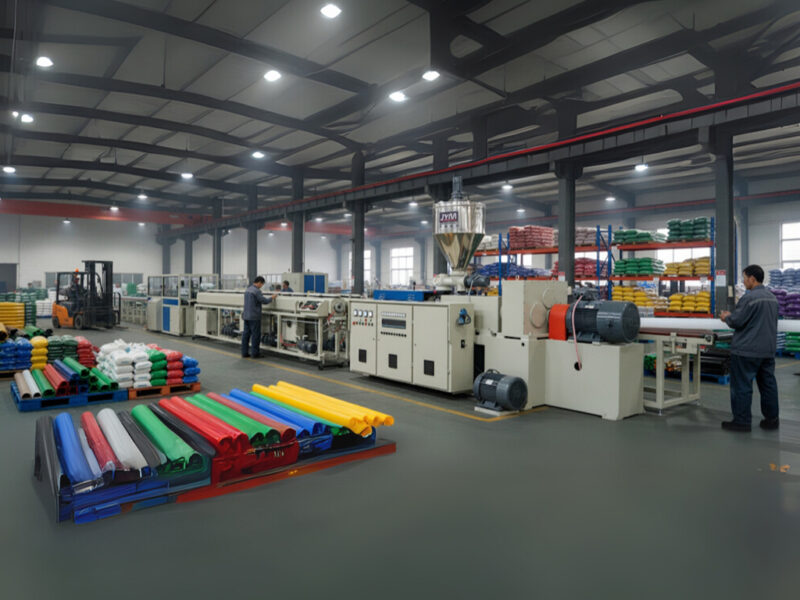
Extrusion is a material-processing technology widely used across many industries. At its core, the method forces molten material through a shaping die to create products with the desired cross-section and form. In the article below, Thái Dương Plastics will help you understand this technology within the scope of plastic extrusion.
What is plastic extrusion?
Plastic extrusion is a plastics-processing method in which polymer pellets are heated, melted, and pushed through a shaping die to form a continuously produced product. After exiting the die, the product is cooled-by water, air, compressed air, etc.-to stabilize its structure.
This method can produce many product forms such as plastic pipes, sheets, films, and plastic-coated wire/cable jackets. A key advantage of plastic extrusion is the ability to run continuously at high volumes while maintaining quality and dimensional consistency.

Advantages and limitations versus other techniques
Compared with other plastics processes such as injection molding, blow molding, or compression molding, extrusion offers clear advantages:
- Ideal for long-length products with continuous profiles (e.g., pipes, bars, sheets).
- Lower die/tooling costs than injection molding, helping optimize production cost.
- High throughput, well-suited to mass production.
- Great flexibility-applicable to many different thermoplastics.
However, extrusion also has limitations. It is not suitable for parts with complex 3D details. Length tolerances and overall dimensional uniformity are generally harder to control than with injection molding, so secondary finishing may be needed where tight specifications are required.
Structure and operating principle of a plastic extruder
The plastic extruder is the core machine in an extrusion line. Its basic construction includes:
- Hopper: Holds pellets before processing.
- Feed throat: The connection between hopper and barrel, feeding material into the heating zone.
- Barrel (heated cylinder): Softens and melts the plastic via multiple controlled heating zones.
- Screw: Rotates inside the barrel to compress, mix, and convey the melt toward the die.
- Breaker plate and screen pack: Filter contaminants and stabilize pressure before the melt enters the die.
- Adapter and extrusion die: Direct the melt and shape it to the desired profile.
- Cooling system: Uses air, water, or chill rolls to fix the product’s shape.
Operation begins by feeding resin into the hopper. Screw rotation generates shear and, together with barrel heat, plasticizes the resin. The molten polymer is pushed through the die to form the profile. After exiting the die, rapid cooling stabilizes dimensions.

Major plastic extrusion processes
There are multiple extrusion variants, each suited to specific products and technical requirements:
Blown Film Extrusion
Commonly used for shopping bags and food wrap. Molten resin is extruded through an annular die, then inflated into a thin tube with air, drawn, and cooled to form film. This method produces very thin films that remain strong and ductile.
Sheet and Flat Film Extrusion
Unlike blown film, this uses a flat T-die to extrude the melt, which then passes through calender (chill) rolls. The goal is to level, gauge, and cool the material into sheet or flat film at the target thickness. Typical products include rigid packaging, thermoformed containers, and engineering sheets.
Profile Extrusion
Suitable for continuous products with complex cross-sections such as plastic bars, window frames, seals, and trims. The die is custom-made to the desired profile to ensure stable dimensions.

Pipe Extrusion
Specialized for water pipes, technical tubing, and straws. As the melt exits the die, internal pressure and sizing are controlled to maintain a uniform hollow structure along the entire length.
Extrusion Coating/Sheathing
Here, plastic is extruded onto a substrate to add protection, insulation, and moisture resistance:
- Wire & cable sheathing/jacketing: Plastic is applied over conductors and cables to create an insulating, moisture-resistant, mechanically robust jacket.
- Coating onto substrates: A thin plastic layer (often polyethylene) is coated onto paper, paperboard, or aluminum film to create multilayer packaging with barrier properties-e.g., milk cartons and paper cups.
Co-extrusion
Two or more extruders run simultaneously to combine multiple plastics into a single multilayer structure. This technique enables enhanced performance-e.g., multilayer packaging with both moisture and gas barriers, or sheets with UV-resistant surfaces.
Applications of extrusion in plastics manufacturing
Extrusion is used widely across sectors:
- Plastic packaging: Shopping bags, food wraps, rigid containers.
- Construction: Water pipes, insulation panels, extruded profiles.
- Electrical & electronics: Wire and cable jackets, insulating covers.
- Automotive: Floor liners, seals, and engineered plastic components.
- Housewares: Straws, trays, and protective sleeves.

Plastic extrusion is a manufacturing technology that optimizes cost and boosts productivity. With its many process variants, extrusion satisfies diverse product requirements across the plastics sector. Understanding the characteristics, machine structure, and applications of extrusion helps businesses choose the right solution to produce high-quality products that meet market needs.
See also: Detailed information on rubber extrusion
